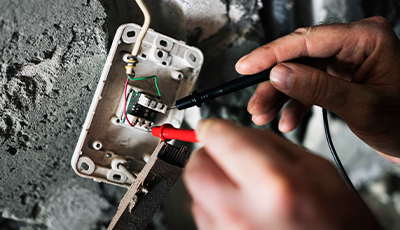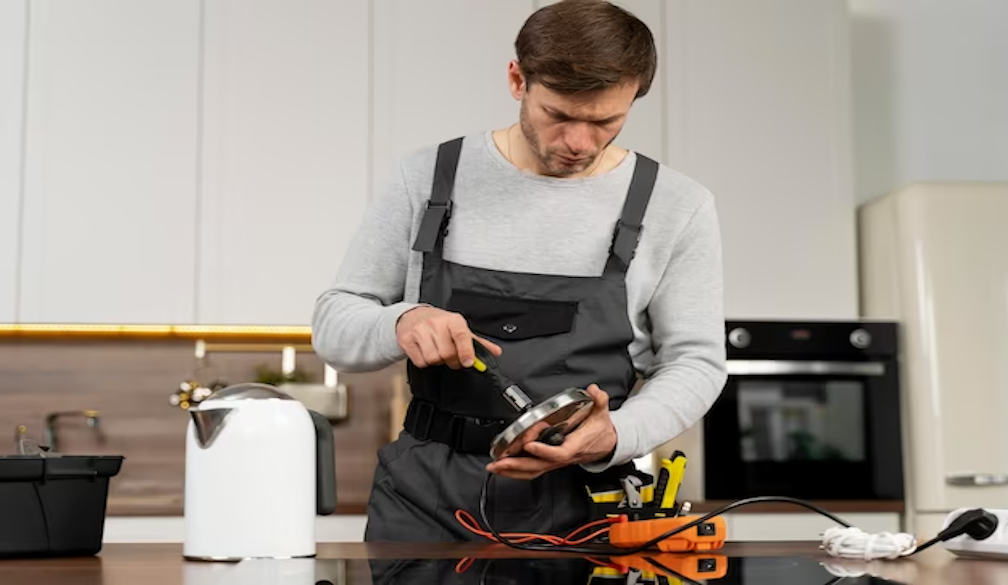Common Electric Troubles Every Home Owner Should Learn about
House owners frequently experience various electrical troubles that can impact security and performance. Issues like flickering lights and tripped breaker are a lot more common than several realize. These situations can suggest deeper electric problems that warrant focus. Recognizing the indications and risks related to outdated wiring and dead electrical outlets is crucial. What procedures can be taken to protect against these issues? Checking out these common electric issues can reveal essential insights for keeping a risk-free home setting.

Flickering Lights: Reasons and Solutions
Why do some house owners experience flickering lights? Flickering lights can be a typical aggravation, frequently indicating underlying electrical issues. One main cause is damaged or loosened connections within lights or circuitry, which can lead to periodic power supply. In addition, making use of high-wattage devices on the very same circuit might trigger voltage variations, causing lowering or flickering. An additional possible concern is an overloaded circuit, where also many devices draw power concurrently, straining the electric system. Outdated or degraded wiring can contribute to inconsistent electric flow. In some instances, flickering lights may signify a trouble with the home's electric panel or service line. Home owners should deal with flickering lights immediately to prevent prospective hazards. Solutions might consist of tightening up links, rearranging home appliance tons, or seeking advice from a qualified electrician for a complete evaluation. Recognizing the origin cause can aid ensure a stable and secure electrical system in the home.
Tripped Circuit Breakers: What You Need to Know
Have house owners ever before questioned what creates their circuit breakers to journey suddenly? This usual issue typically develops from an overload of electrical circuits, where way too many gadgets draw power at the same time. In such situations, the circuit breaker acts as a safety and security system, disrupting the flow of electrical power to avoid overheating and possible threats. One more constant cause is a brief circuit, which happens when a live cord contacts a neutral cable, creating a rise of electrical power that journeys the breaker. Ground faults can likewise cause stumbled breakers; these happen when a live cord touches the ground or a grounded surface area, posturing severe safety threats. House owners need to on a regular basis evaluate their use of high-wattage appliances to prevent straining circuits. In addition, recognizing the function of circuit breakers can aid them react properly throughout a journey, guaranteeing their home remains risk-free and properly maintained.
Outdated Wiring: Threats and indicators
Out-of-date circuitry can position considerable dangers to property owners, commonly going unnoticed up until troubles develop. Residences constructed before the 1980s might still have light weight aluminum circuitry or knob-and-tube systems, which are no more considered secure. Signs of obsolete electrical wiring consist of flickering lights, regularly stumbled breaker, or shedding scents near outlets. These signs might recommend that the electrical system is loaded down or deteriorating.Additionally, home owners could discover blister marks around buttons or electrical outlets, which can indicate getting too hot. The threat of electrical fires markedly increases with obsolete circuitry, as these systems were not created to take care of contemporary electric tons. Home owners are encouraged to have their wiring examined consistently, particularly when refurbishing or including new appliances. By acknowledging these indications early, they can avoid harmful circumstances and maintain a more secure living setting. Updating to present electric criteria is a positive action in keeping home safety and security and effectiveness.
Often Blown Fuses: Troubleshooting Tips
Constant blown integrates can suggest underlying electrical concerns that may originate from outdated circuitry or overloaded circuits. Property owners experiencing this problem needs to first recognize the devices connected to the influenced circuit. It is recommended to avoid utilizing numerous high-wattage tools concurrently, as this can lead to circuit overload. If the problem persists, checking the circuit box for indications of wear or damage is vital; a damaged circuit box might call for replacement.Additionally, looking for loose links within the circuit can aid stop future events. Home owners should additionally verify that the integrates being utilized are of the proper amperage, as making use of an incorrect fuse can intensify the issue. Consulting a certified electrician is recommended to assess the electrical system further if these repairing suggestions do not solve the problem. Dealing with these concerns without delay can help mitigate threats and assure the safety and security of the home's electric facilities.
Dead Outlets: Common Reasons and Fixes
When a homeowner experiences a dead outlet, it can typically provide irritation and confusion. A number of usual causes might bring about this concern. One regular wrongdoer is a tripped breaker, which can be conveniently reset. If any breakers are in the off position, homeowners must evaluate their electrical panel to check. Another opportunity is a malfunctioning electrical outlet itself, which may call for substitute. Furthermore, loosened wiring connections within the electrical outlet can interrupt power circulation, making inspection essential.Sometimes, the problem might stem from an overloaded circuit, especially when several gadgets are attached. In such instances, redistributing the electric tons can solve the problem. House owners need to additionally think about the age of their circuitry; older systems might need updates to meet contemporary electrical needs. If these actions do not correct the circumstance, speaking with a licensed electrical expert is suggested to ensure safety and appropriate diagnosis.
Electric Shocks: When to Be Worried
Exactly how can homeowners determine whether an electrical shock warrants worry? Home owners must initially analyze the extent and context of the shock. A moderate static shock, usually really felt when touching steel items, is common and commonly harmless. If the shock happens while interacting with a plugged-in device or electrical outlet, it might suggest a much more severe issue.The location and frequency of the shocks are important. Repetitive shocks from the very same resource, especially in wet locations like cooking areas or washrooms, can signify defective wiring or poor grounding. Home owners ought to likewise think about the experience of the shock; a jolt that triggers discomfort or muscle mass tightenings is extra alarming than a mere tingle.If there's any type of unpredictability, it is suggested to consult a qualified electrical expert. Neglecting prospective electrical threats can result in severe safety risks, consisting of fire or severe injury.
Overloaded Circuits: Avoidance and Precaution
Overloaded circuits position significant dangers in property settings, typically bring about electric fires or equipment damages (ASP Level 2 Electrician). Home owners should recognize the indications of an overloaded circuit, such as regularly stumbled breakers or lowering lights. Applying preventative safety and security techniques can aid mitigate these threats and ensure a more secure living atmosphere
Identifying Overloaded Circuits
What indications indicate that a circuit may be strained? Property owners need to be attentive for a number of crucial indicators. Regularly stumbled circuit breakers or blown fuses recommend too much load on the circuit. Lowering or flickering lights, specifically when other appliances are in usage, can represent an inadequate power supply. In addition, electrical outlets or buttons that really feel warm to the touch might suggest overheating, a potential fire risk. Uncommon buzzing noises from outlets also require attention, as they can symbolize electric problems. Ultimately, if home appliances run inefficiently or fail to begin, it may be an indication of an overloaded circuit. Identifying these signs early can help stop serious electric issues and advertise a safer home setting.
Preventive Security Practices
To maintain a efficient and safe electric system, house owners need to carry out preventive safety methods that attend to prospective circuit overloads. One reliable procedure is to avoid connecting way too many devices to a solitary outlet, as this can surpass the circuit's capacity. Utilizing power strips with integrated circuit breakers can assist distribute power safely. Homeowners ought to also on a regular basis examine cords and home appliances for damages and change any kind of damaged this website devices without delay. It is crucial to assure that circuit breakers are working appropriately and to be familiar with the total electrical power being utilized in each circuit. Furthermore, seeking advice from a licensed electrician for routine inspections can determine possible problems prior to they rise, assuring a much safer living atmosphere and prolonging the life expectancy of electric systems.
Frequently Asked Questions
Just how Typically Should I Have My Electric System Inspected?
Normal evaluations of electrical systems are suggested every 3 to five years. Homeowners ought to take into consideration a lot more regular checks if from this source they experience concerns, carry out renovations, or reside in older buildings to assure safety and security and compliance.
Can I Repair Electrical Problems Myself or Employ an Expert?

What Are the Signs of an Electric Fire Threat?
Indicators of an electrical fire threat include often stumbled circuit breakers, flickering lights, shedding smells, stained electrical outlets, or cozy, humming wires. House owners need to remain watchful and look for expert support if any one of these indicators exist.
Exactly how Do I Know if My Home Needs an Electrical Upgrade?
To identify if a home requires an electrical upgrade, indicators include constant circuit breaker trips, outdated wiring, insufficient outlets, flickering lights, and the presence of older electrical panels, indicating prospective safety and security threats and inefficiency.
Are There Details Safety Tips for Do It Yourself Electrical Job?
When thinking about DIY electric work, one should constantly switch off power, utilize insulated tools, validate circuit performance, adhere to neighborhood codes, and consult specialists for complicated jobs to guarantee security and prevent crashes. An additional possible concern is an overloaded circuit, where also lots of devices attract power all at once, straining the electrical system. The danger of electrical fires considerably increases with obsolete circuitry, as these systems were not developed to handle contemporary electrical lots. Regular blown integrates can show underlying electric problems that may stem from out-of-date electrical wiring or overloaded circuits. To preserve a risk-free and effective electrical system, homeowners have to apply preventive safety techniques that address prospective circuit overloads. Accredited Service get redirected here Provider Level 2 Electrician. Indications of an electrical fire threat include often tripped circuit breakers, flickering lights, melting smells, stained electrical outlets, or warm, humming wires